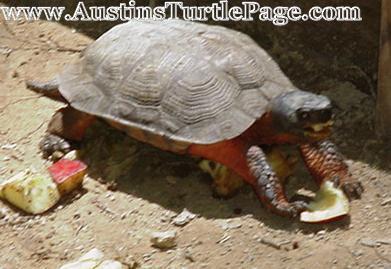|
North American Wood Turtle |
By Hikefish & Sfrese
|

|
|
Photo by Hikefish |
Glyptemys insculpta
Male
7.5 - 8.5”
Female
7 - 8.25”
These turtles will
eat anything that is edible. By nature, they are omnivores, consuming both
animal and plant matter. However, they tend to be more carnivorous than
anything else. In the wild they eat a variety of things. These include worms,
crayfish, fish, beetles, ants, and even mice. As far as plant matter goes,
their favorite plants are wild blueberries, raspberries, and strawberries.
Based on observations in the wild, they eat anything that will fit in their
mouth and is edible.
Air Temperature:
70 - 80°F
Basking Temperature:
85°F
Water Temperature:
60
- 70°F
In the wild, these turtles seldom
leave the vicinity of water. They are mostly found in cold water streams that
rarely get above 70*F in the summer. The streams are usually unpolluted and
very shaded. These turtles use the streams for mating and hibernation.
However, they will leave them in search of food and to lay eggs. Streams that
wood turtles inhabit are usually small but at least 2 feet deep for hibernation.
Found in the Northeast from MD on
northward. Most common in Pennsylvania. They are also found in MD, NY, MA, ME,
VT, and NH
Yes
The captive habitat of this species
can be either very simple or elaborate. There are a few simple requirements
that should be met however. Adults need to have a water area that is 2 feet
deep and stays under 70 degrees. If the correct water temp isn’t maintained,
these turtles can overheat and die very easily. Also, they should have plenty
of shade in order to keep cool. The key with this species, is to keep the
temperatures of the habitat cool. Room temperature usually works great as long
as there is a basking spot. As far as substrate goes, top soil can be used as a
great medium. A UVB light should be used to keep all turtles healthy. There
should be a lot of sight barriers in the pen in order to keep adults from
fighting/breeding all the time.
By far, the best enclosure for a wood
turtle is outdoors. A single adult would do fine in a 5 ft x 5 ft enclosure
with a pond of at least 2 feet in depth and about half the size of the pen.
Multiple adults would do fine with an extra 4 sq. feet of space per adult. If
you absolutely must house adults indoors, nothing less than a small kiddy pool
should be used. A 50 gallon Rubbermaid is simply too small for an adult wood
turtle. With housing indoors, it should only be temporary so that you don’t
compromise the health of your turtle. Hatchlings and juvenile wood turtles can
be housed indoors until they get to about 5 inches in Straight Carapace Length.
After that time, they should be moved to an outdoor enclosure.
They will eat anything in captivity.
The best thing for them is to keep Hosta plants in the enclosure, they will
nibble and eat these plants. As far as animal matter goes, they will eat
earthworms, night crawlers, mealworms, crickets, crayfish, and pre killed mice.
As far as animal matter goes, they will eat apples, pears, blueberries,
strawberries, romaine lettuce, radicchio, carrots, and various non-toxic leafy
plants.
These turtles can be kept together
with other wood turtles. NO MORE THAN ONE MALE PER ENCLOSURE!!! Males will
fight to the death if kept together. Wood turtles can also be kept with box
turtles and sliders/basking turtles. Turtles kept with adult wood turtles
should be at least 6 inches long to prevent injuries.
Even though these
turtles do not have much webbing on their feet, they are very strong swimmers
and should be provided with a deep water area. If you plan on breeding these
turtles, females MUST have a sandy loam area to lay eggs. This can be made of
40-45% sand and 55-60% top soil. If this isn’t provided, they will simply lay
the eggs in water, which could cause embryo death.